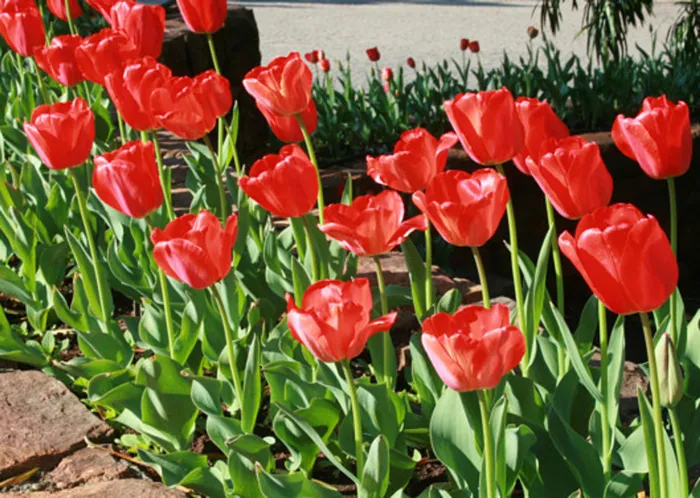Autumn still fruitful

Cool blooms: May is the month to plant tulip bulbs for flowering in August. Picture: Lukas Otto Cool blooms: May is the month to plant tulip bulbs for flowering in August. Picture: Lukas Otto
May is a transitional month in the garden. Autumn fades into winter and by the end of May, days are short and nights frosty. The summer garden is nearing its end, but there is still time to plant seedlings for colour this winter. May is also the time to plant tulips, sow a seed lawn, lift the dahlias and fertilise the sweetpeas.
Seedlings for colour
It is too late to plant the seeds for winter-flowering annuals, but now is the time to plant established winter- and spring-flowering seedlings. Sweetpeas, Iceland poppies, pansies, snapdragons, dianthus, petunias, phlox, larkspur, foxglove, verbena and delphiniums are ideal for a sunny corner. Fairy primula (Primula malacoides) is the queen of the winter shade garden and is available in shades of white, lilac, cerise and pink.
Remember that sweetpeas often need an extra boost of potassium in the form of 3.1.5. Spray a solution of Nitrosol, Seagro or Multifeed P as a foliar feed onto all winter seedlings every two weeks.
The historical average May monthly rainfall for Gauteng is usually around 25mm and last week’s rain will probably be the end of the summer rain. Dry weather is likely to now set in. For the benefit of the all winter and spring flowering annuals, one must continue watering once a week. Preferably in the morning, so that the foliage has time to dry before nightfall and the onset of May’s chilly evenings.
Time for tulips
Tulips are the last of the autumn bulbs to be planted and thrive in cold, frosty, low-lying or south-facing gardens. Although modern hybrids are adapted to warm conditions, avoid planting them beside a north-facing white wall where the microclimate is positively tropical.
Rather situate tulips against an east-facing wall or in an east-facing bed, where they get morning sun but are protected from the harsh midday and afternoon sun. Plant tulips 12cm apart and about 8cm below the soil surface. Any deeper and the soil is too warm.
The secret to successful tulip growing is water. This means watering thoroughly at least once a week during the Highveld winter. Newly bought bulbs have been specially prepared by the bulb companies and all have flower embryos waiting to burst forth with colour in spring.
For this reason, feeding bulbs is not as critical as watering them regularly. However, if you want a splendid display in August, a two-weekly dose of commercially manufactured bulb food or liquid fertiliser can only benefit the plants.
Sow an evergreen lawn
May is also the month to sow or lay an evergreen cool-season lawn. The advantage of these is that they stay green for 12 months of the year.
Varieties such as Shade Over are suited to densely shaded areas where kikuyu doesn’t grow, whereas All Seasons Evergreen or Leisure Lawn can tolerate both sun and partial shade. Instant All Seasons Evergreen in sod form is ideal for townhouse gardens. All cool-season lawns require water regularly and the blade of the grass must never be cut shorter than 6cm.
Plant a confetti bush
Autumn is a great time to plant the indigenous confetti bush (Coleonema pulchellum) with their pretty pastel blooms from May to September. The flowers’ nectar attracts butterflies, bees and other small insects, which, in turn, attract birds.
Confetti bushes tolerate mild to moderate frost, and autumn is the best time to plant them. Choose a sunny spot where the soil drains well. Add acid compost to the planting hole as confetti bushes prefer slightly acidic soil. Water regularly in winter and fertilise monthly with a slow-release general fertiliser or an organic fertiliser. Prune to shape after flowering.
Maintenance
Finally, remember the odd jobs in May. Cut cannas back after the first frosts, and pinch out the tips of sweetpeas when they get to 15cm in height. Reduce water to the indigenous agapanthus and clivia. Both need a semi-dormancy before flowering next summer.
Wait until the foliage of the dahlias has turned yellow before lifting them. If you cut them down early their storage tubers will have their nutrient supply disrupted.
Keep watering citrus trees and camellias.
Lightly prune plectranthus as soon as it has finished flowering.
Protect tender plants with hessian teepees at night, particularly if you have a cold garden. The frosts are on their way. - Saturday Star